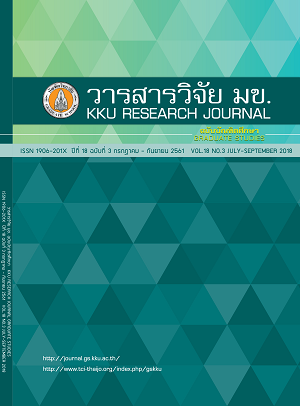Drought Risk Area Assessment Using Remotely Sensed Data and Meteorological Data in Chern Sub-watershed
Keywords:
Drought, Remotely sensed data, Meteorological dataAbstract
The objectives of this study were to find out the drought parameter index and assess drought risk in Chern Sub-watershed using remotely sensed data which are Normalized Difference Water Index (NDWI), Land Surface Temperature (LST) and Vegetation Health Index (VHI) from level 3 of Aqua/MODIS and meteorological data as Standardized Precipitation Index (SPI). Spatial analysis techniques in GIS and pairwise comparison were used for identified weighting score of each parameter. Drought risk map was verified by redundant drought data from Land Development Department (LDD) using overall accuracy index. The results found that NDWI ranged was 0.25 - 0.46, LST ranged was 28.02 - 39.79 °C, VHI ranged was 49.32 - 55.67 and SPI ranged was (-1.96) - 0.003. Drought risk area assessment showed that about 1,169.06 km2 or 39.90% of the watershed area was under extreme drought risk. Drought risk area comparison through overall accuracy showed high accuracy was 96.17% in extreme drought risk area which was Chum Phae district, Khon Kaen province with 277.38 km2 or 9.47% of watershed area and 370 villages of 9 districts were drought risk area.
References
2. Department of Disaster Prevention and Mitigation. Drought statistics [Internet]. 2014 [update 2017 Nov 11; cited 2018 Apr 27]. Available from: https://122.155.1.141/inner.directing-6.191/cms/menu_4469/3606.1/
3. Geo-Informatics and Space Technology Development Agency (Public Organization) [Internet]. 2018 [update 2010 Mar 31, cited 2018 Aug 3]. Available from: https://www.gistda.or.th/main/th/node/332
4. Saengmitr S, Sukawat D. Drought in Thailand. Meteorological Department; 1981. Thai.
5. Wihite DA, Glantz MH. Understanding the Drought Phenimenon: The Role of Definition. International Journal of Water. 1985; 10, No.3: 111-120.
6. McFeeters SK. The use of normalized difference water index (NDWI) in the delineation of open water features. Int J Remote Sens. 1996; 17 (7): 14253-1432.
7. Petchsawang A. Humidity map from satellite data [Internet]. 2015 [update 2015 Jul 28; cited 2017 Nov 20]. Available from: https://www.gistda.or.th/main/th/node/802
8. Wan Z. Collection-6 MODIS land surface temperature products users' guide. Earth Research Institute, University of California. Santa Barbara; 2013.
9. Kogan FN. Application of vegetation index and brightness temperature for drought detection. Advances in Space Research. 1995; 15: 91-100.
10. Kogan FN, Sullivan J. Development of a global drought-watch system using NOAA/AVHRR data. Advances in Space Research. 1993; 13: 219-222.
11. Jensen JR. Remote sensing of the environment: An Earth Resource Perspective, Prentice-Hall, Inc. 2000; 592 p.
12. Singh RP, Roy S, Kogan F. Vegetation and Temperature Condition Indices from NOAA AVHRR Data for Drought Monitoring over India. Int J Remote Sens. 2003; 24: 4393-4402.
13. Amalo LF, Hidayat R, Haris. Comparison between remote-sensing-based drought indices in East Java. Earth and Environmental Science. 2017; 54: 1755-1315.
14. McKee TB, Doesken NJ, Kleist J. The relationship of drought frequency and duration to time scales. Preprints of the 8th Conference on Applied Climatology; 1993 Jan 17-22; Anaheim, California.
15. Tingsanchali T, Piriyawong T. Drought risk management in watershed area case study Moonboon-Lamsae watershed in Administration and management of water for reduce drought. The Engineering Institute of Thailand; 2015. Thai.
16. Kasetsart University. Automatic Drought Modelling and Mapping. Final report. Geo-Informatics and Space Technology Development Agency (Public Organization); 2016. Thai.
17. Ukrainski P. Classification accuracy assessment confusion matrix method [Internet]. 2016 [update 2016 Sep 23; cited 2017 Nov 20]. Available from: https://www.50northspatial.org/classification-accuracy-assessment-confusion-matrix-method/
18. Geo-informatic Applications and Service Office. Drought and crop area with geo-information report. Geo-Informatics and Space Technology Development Agency (Public Organization); 2016 May 13. 6p. Thai.
19. Salee W. Prediction of drought category using loglinear models based on SPI in the Northeast of Thailand [MSc thesis]. Nakhon Pathom: Silpakorn University; 2009. Thai.


